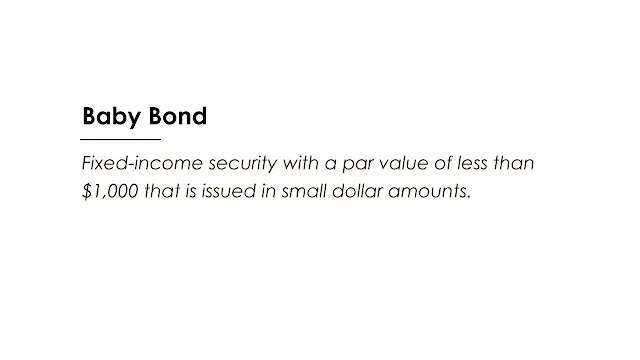
|
| Image: Moneybestpal.com |
Baby bonds are fixed-income securities with a par value of less than $1,000 that are issued in small dollar amounts.
They are meant to draw regular people who might not have a lot of money to invest in conventional bonds. Numerous organizations, including local governments, counties, states, corporations, and even the federal government, issue baby bonds.
Baby bonds have the callability property, which allows the issuer to redeem them prior to maturity. It also exposes bondholders to reinvestment risk in the event that interest rates decrease. This allows the issuer some flexibility in managing its debt commitments.
Another characteristic of baby bonds is that they are frequently unsecured, which means they are not supported by any kind of security. They are thus riskier than secured bonds, albeit they may also offer greater potential rewards.
To understand the benefits and drawbacks of baby bonds, let us look at some examples and alternatives.
Example 1: Municipal Baby Bonds
Municipal baby bonds are a type of public debt that are issued by local governments to pay for public works and services including infrastructure, education, and healthcare. They are often tax-exempt, which means that the interest income is exempt from federal and, occasionally, state and municipal taxes. Investors in high tax brackets who seek income and diversity find them appealing because of this.
For instance, let's say a city issues $10 million worth of baby bonds with a $25 par value, a 4% coupon rate, and a 10-year maturity. A credit rating firm has given the bonds an A rating, suggesting a low chance of default. An investor who invests $2,500 in 100 bonds will receive $2,500 at maturity ($25 x 100) plus $100 in annual interest payments ($25 x 4% x 100). The bonds' after-tax yield is 5.26% if the investor is in the 24% federal tax bracket (4% / (1 - 0.24)).
Municipal baby bonds, however, also come with a few drawbacks. First, because they are vulnerable to interest rate risk, their prices will drop as interest rates rise. For instance, if the interest rate on comparable bonds rises to 5%, the price of the city's baby bonds will fall to $21.74 ($25 / (1 + 0.05) 10), resulting in a loss of capital for the investor who purchased them at $25.
Second, they are exposed to call risk, which means that if interest rates fall, the issuer may redeem them prior to maturity. For instance, the city might decide to call the baby bonds and issue new ones at a reduced price if the market interest rate on comparable bonds falls to 3%. The investor will no longer get future interest payments as a result, and they will be forced to reinvest their money at a lesser rate.
Example 2: Corporate Baby Bonds
Businesses issue corporate baby bonds to obtain money for a range of needs, including expansion, acquisition, debt refinancing, and other things. Generally speaking, they are taxable, which means that the interest income is subject to federal and occasionally state and local taxes. As a result, investors in high tax brackets looking for income and diversity find them less appealing.
Consider a utility business issuing $50 million worth of baby bonds, each with a par value of $50, a 6% coupon rate, and a 15-year maturity. A credit rating firm has given the bonds a BBB grade, suggesting a moderate default risk. An investor who invests $5,000 in 100 bonds will earn $5,000 at maturity ($50 x 100) plus $300 in yearly interest payments ($50 x 6% x 100). The bonds' after-tax yield is 4.55% if the investor is in the 24% federal tax rate (6% x (1 - 0.24)).
But there are also some drawbacks to corporate baby bonds. Their prices will decrease as the issuer's financial situation worsens or when its credit rating is reduced, as they are first vulnerable to credit risk. The price of the utility company's baby bonds, for instance, will drop to $38.71 ($50 / (1 + 0.08) 15), causing a capital loss for the investor who purchased them at $50 if the utility business experiences financial difficulties or is downgraded to BB by a credit rating agency, signaling a significant default risk.
Second, they are exposed to call risk, which means that if interest rates fall, the issuer may redeem them prior to maturity. The power firm might elect to cancel the baby bonds and issue new ones at a cheaper price if, for instance, the market interest rate for comparable bonds falls to 4%. The investor will no longer get future interest payments as a result, and they will be forced to reinvest their money at a lesser rate.
Alternatives to Baby Bonds
Some alternatives to baby bonds are:
- Savings bonds: These are federal government-issued debt securities with a fixed or variable interest rate and expiration dates that allow for redemption. Although they have modest yields and restricted liquidity, they are typically seen as secure and tax-favored investments.
- Exchange-traded debt securities (ETDs): These are corporate debt securities that are traded on stock markets similarly to equities. They pay a fixed or variable interest rate and often have par values of $1,000 or higher than baby bonds. Compared to baby bonds, they provide more liquidity and transparency, but at the expense of increased transaction costs and market risks.
- Preferred stocks: These securities are a hybrid type that combines elements of both stocks and bonds. In addition to having a greater claim on the issuer's assets and earnings than common stocks, they pay a fixed or variable dividend that is typically higher than the interest rate on baby bonds. Although they do not have voting rights or the possibility for appreciation, they also have a lesser priority than baby bonds in the event of bankruptcy.

